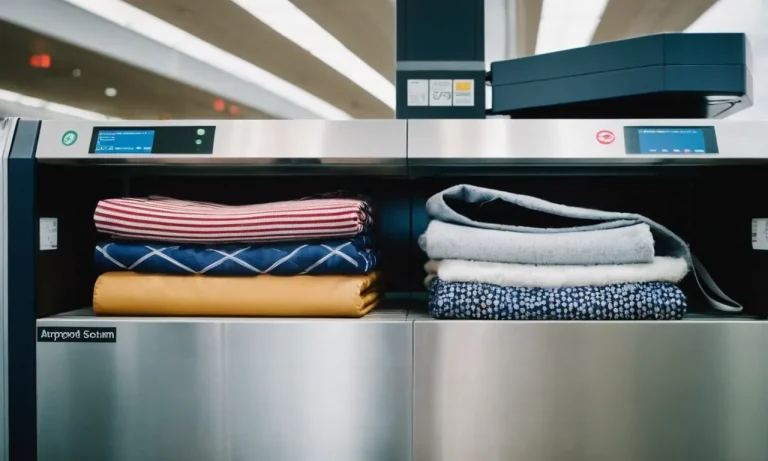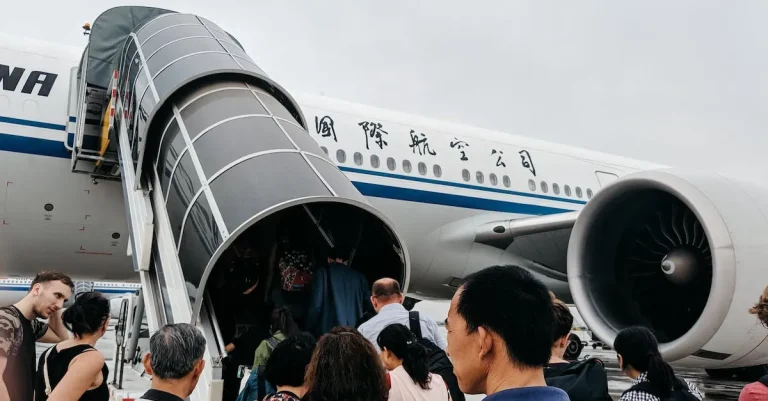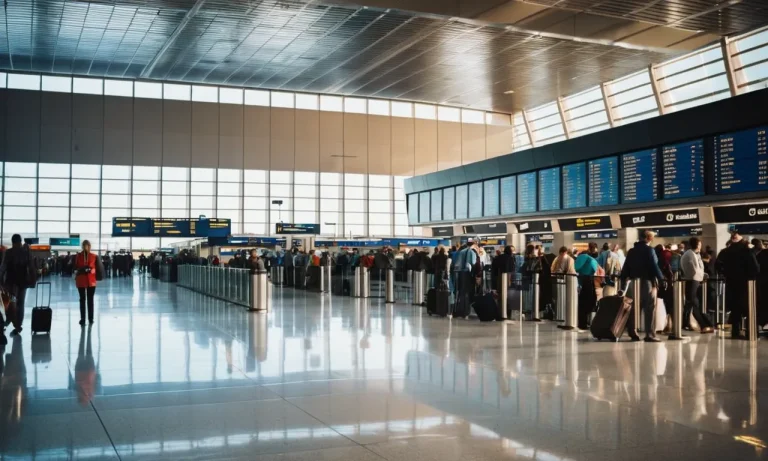Getting selected for a pat-down by a TSA agent during airport security screening can be bewildering, especially if it seems to happen to you every time you fly.
You may wonder if you’re doing something to trigger the extra screening.
If you’re short on time, here’s a quick answer:
There are several reasons why some travelers get repeatedly picked for pat-downs, including random selection, body scanner alarms, bulky clothing, and anomalies detected during screening.
In this comprehensive guide, we’ll examine the various factors that can lead to frequent airport pat-downs.
We’ll look at TSA screening protocols, body scanner technology, common pat-down triggers, steps you can take to potentially reduce pat-downs, and what to expect during the process.
Understanding TSA Screening Protocols
When it comes to airport security, the Transportation Security Administration (TSA) plays a crucial role in ensuring the safety of travelers.
One aspect of their protocols that often raises questions is the frequent pat-downs some passengers experience.
To shed light on this issue, let’s delve into the factors that influence the TSA’s selection process and the circumstances that may lead to a pat-down.
How the TSA Selects Passengers for Extra Screening
The TSA employs a variety of methods to determine which passengers should undergo additional screening.
While the exact criteria are not publicly disclosed for security reasons, it is known that the selection process involves a combination of random selection and behavior-based indicators.
This means that even if you are a low-risk traveler with no suspicious behavior, you may still be chosen for additional screening simply due to the random nature of the selection process.
Additionally, the TSA may also use intelligence-driven techniques to identify potential threats.
This could involve cross-referencing passenger information with watchlists or analyzing patterns of travel.
While these methods are designed to enhance security, they can sometimes result in innocent travelers being selected for additional screening.
Pat-Downs Used When Scanners Detect Anomalies
One common reason for receiving a pat-down at the airport is when the security scanners detect anomalies during the screening process.
These anomalies can include items such as metal objects, dense clothing, or prosthetic devices that may raise suspicions.
In such cases, the TSA officer will conduct a thorough pat-down to ensure there are no hidden threats.
It is important to note that the scanners used by the TSA are highly advanced and designed to minimize false alarms.
However, due to the complexity of the human body and the materials we wear, occasional false positives can occur.
If you find yourself being selected for a pat-down, it is essential to remain calm and cooperative, as the TSA officers are simply following necessary protocols to ensure everyone’s safety.
Random Selection Plays a Role in Pat-Down Frequency
Random selection is an integral part of the TSA’s screening protocols.
As mentioned earlier, even if you are a low-risk traveler, you may still be chosen for additional screening purely by chance.
This randomness is essential to maintain the unpredictability of the selection process and prevent potential threats from exploiting patterns or loopholes.
While it can be frustrating to be consistently chosen for pat-downs, it is essential to remember that it is not a personal judgment or discrimination.
The TSA’s primary goal is to ensure the safety of all passengers, and their protocols are designed to achieve this objective.
By understanding the random nature of the selection process, it can help alleviate any feelings of frustration or confusion.
New Body Scanner Technology and Its Limitations
As airport security measures continue to evolve, one of the most significant developments in recent years has been the introduction of body scanner technology.
These scanners are designed to enhance the detection of potential threats and improve overall passenger safety.
However, like any technology, body scanners have their limitations, which can sometimes result in increased pat-down rates for certain individuals.
How Body Scanners Work to Detect Potential Threats
Body scanners operate by using a form of imaging technology to create a detailed image of a person’s body, revealing any concealed items that may pose a security risk.
There are two main types of body scanners: millimeter wave scanners and backscatter scanners.
Millimeter wave scanners use radio waves to create an image of the body, while backscatter scanners use low-level X-rays.
These scanners are highly effective at detecting a wide range of potential threats, including metallic and non-metallic items, such as weapons, explosives, and other prohibited items.
The scanners can identify both concealed objects on the body’s surface and those hidden beneath clothing.
This advanced technology has significantly improved airport security by providing a more thorough screening process.
Scanners Flag Anomalies Including Folds in Clothing
While body scanners are highly advanced, they are not without their limitations.
One limitation is that they can sometimes flag innocent anomalies during the scanning process, leading to further inspection or pat-downs.
For example, folds in clothing, jewelry, or even body piercings can trigger an alert on the scanner, requiring additional screening.
It’s important to note that these anomalies do not necessarily indicate the presence of a threat, but the scanners are programmed to err on the side of caution.
This means that even innocent passengers may be subjected to additional security measures, such as pat-downs, to ensure the safety of all travelers.
Limitations Lead to Higher Pat-Down Rates in Some Cases
Due to the limitations of body scanner technology, there are instances where individuals may be more likely to undergo a pat-down.
For example, passengers who are wearing loose or layered clothing, or those who have medical devices or prosthetics, may trigger an alert on the scanner and require further inspection.
Additionally, certain cultural or religious practices may involve clothing or accessories that can potentially trigger an alert on the scanner.
In these cases, individuals may choose to undergo a pat-down as an alternative to passing through the body scanner.
It’s important to remember that the goal of airport security is to ensure the safety of all passengers.
While the introduction of body scanner technology has significantly enhanced security measures, it’s not a flawless system.
The limitations of the technology can sometimes result in increased pat-down rates for certain individuals, but these measures are in place to maintain the highest level of safety and security at airports.
Clothing and Accessory Choices That Commonly Trigger Pat-Downs
Bulky, Loose or Multi-Layered Clothing
One of the main reasons for being subjected to a pat-down at the airport is wearing bulky, loose, or multi-layered clothing.
These types of clothing can hide potential threats or prohibited items, making them a concern for airport security.
It is important to note that while comfort is a priority for travelers, certain clothing choices may raise suspicion and result in additional screening.
For example, wearing oversized jackets, baggy sweaters, or loose-fitting pants can create a challenge for security personnel to determine if there is anything concealed underneath.
Additionally, clothing with multiple layers can make it difficult for security scanners to get a clear image of what is underneath, leading to the need for a pat-down.
Metal Buttons, Buckles, Jewelry and Accessories
Metallic items such as buttons, buckles, jewelry, and accessories can trigger pat-downs during airport security screenings.
These items often set off metal detectors, prompting further examination by security personnel.
It is advisable to remove excessive metal items and place them in a bin provided for screening to avoid delays and additional screening measures.
While small metal items like buttons or zippers may not necessarily lead to a pat-down, larger or more conspicuous metallic accessories like belts with large buckles or chunky jewelry can attract attention.
It is crucial to consider the potential impact of such items before heading to the airport to minimize the chances of being selected for a pat-down.
Shoes That Conceal the Foot and Ankle Area
Footwear that conceals the foot and ankle area is another factor that can lead to a pat-down at the airport.
Certain types of shoes, such as boots or high-top sneakers, may require additional screening due to the potential for items to be hidden inside or underneath them.
Security personnel may request the removal of such shoes for closer inspection or perform a pat-down to ensure there are no concealed items.
It is recommended to choose shoes that are easy to take off and put back on, as this can help streamline the screening process and reduce the likelihood of a pat-down.
Remember that airport security measures are in place to ensure the safety of all passengers.
While it may be inconvenient to undergo a pat-down, it is essential to cooperate with security personnel and follow their instructions for a smoother and more efficient screening process.
Physical Traits and Behaviors Linked to More Pat-Downs
When it comes to airport security, certain physical traits and behaviors can increase the likelihood of being selected for a pat-down.
While the selection process is primarily random, there are factors that may draw the attention of security personnel.
Let’s explore some of these factors in more detail:
Height and Body Size
Height and body size can play a role in the likelihood of being selected for a pat-down.
Individuals who are exceptionally tall or have a larger body size may be subject to additional screening.
This is because their physical proportions can make it more difficult for security scanners to obtain clear images of their bodies.
Consequently, security officers may opt for a pat-down to ensure there are no concealed items.
Medical Devices and Conditions
Individuals with medical devices or conditions that cannot be easily identified by scanning machines may be subjected to pat-downs.
This is done to ensure that these individuals are not carrying prohibited items or concealing dangerous substances.
Medical devices such as pacemakers, insulin pumps, or prosthetic limbs may trigger an alert during the scanning process, leading to a pat-down for further investigation.
It’s worth noting that individuals with medical conditions or devices are encouraged to inform security personnel in advance to facilitate a smoother screening process.
Exhibiting Signs of Anxiety or Stress
Behavioral cues can also influence the likelihood of being selected for a pat-down.
Individuals who exhibit signs of anxiety or stress while going through security screening may attract more attention from security officers.
These signs can include excessive fidgeting, sweating, or avoiding eye contact.
It’s important to remember that security personnel are trained to identify potential threats, and displaying nervous behaviors can inadvertently draw attention, resulting in more extensive screening measures.
While being selected for a pat-down can be inconvenient, it’s crucial to remember that airport security measures are in place to ensure the safety of all passengers.
By understanding the factors that may increase the likelihood of being selected for a pat-down, individuals can be better prepared and navigate the screening process more smoothly.
Actions That May Reduce (But Not Eliminate) Pat-Down Frequency
1. Wearing Fitted Clothing Without Much Metal
One way to potentially reduce the frequency of airport pat-downs is to wear fitted clothing without excessive metal.
Loose or baggy clothing can sometimes trigger the security scanners, leading to additional screening.
Opting for well-fitting attire can minimize the chances of setting off any alarms.
Additionally, it’s important to avoid wearing clothing with too many metal accessories such as belts or bulky jewelry, as these can also raise red flags during the screening process.
2. Using TSA PreCheck When Available
If you find yourself frequently subjected to pat-downs at the airport, it might be worth considering applying for TSA PreCheck.
This program allows pre-approved travelers to enjoy expedited screening lines, bypassing some of the more invasive security measures.
TSA PreCheck members are typically not required to remove their shoes, laptops, liquids, belts, or light jackets during the screening process, reducing the likelihood of being singled out for a pat-down.
3. Moving Through Screening Calmly and Efficiently
The way you navigate through airport security can also play a role in determining whether or not you’ll be subjected to a pat-down.
Acting calmly and efficiently during the screening process can help minimize the chances of additional scrutiny.
Follow the instructions provided by the Transportation Security Administration (TSA) officers, remove any required items from your pockets, and place them in the designated bins.
Avoid making sudden or suspicious movements that could raise concerns.
By moving through the screening process smoothly and confidently, you can decrease the likelihood of being selected for a pat-down.
While these actions may help reduce the frequency of pat-downs, it’s important to note that they do not guarantee complete avoidance.
Random selection, unpredictable security measures, or certain factors that may be specific to an individual’s background or travel history can still result in a pat-down.
Nonetheless, by following these tips and maintaining a cooperative attitude, you can increase the chances of a hassle-free experience at the airport.
What to Expect During the Pat-Down Process
Notification of the Pat-Down and Choice to Opt Out
When going through airport security, it is important to familiarize yourself with the procedures that may be conducted.
If you are selected for a pat-down, a Transportation Security Administration (TSA) agent will inform you and explain the reason for the pat-down.
This can happen for various reasons, such as an alarm being triggered during the screening process or if you are randomly selected for additional screening.
If you are uncomfortable with the idea of a pat-down, you have the right to opt out and request an alternative screening method.
This could include a private screening or the use of advanced imaging technology.
It is important to communicate your preference to the TSA agent in a calm and respectful manner.
The Agent’s Explanation of the Procedure
During the pat-down, a TSA agent of the same gender as you will conduct a thorough search of your body using their hands.
The agent will explain each step of the procedure before it begins, ensuring that you understand what will happen.
They should also address any concerns or questions you may have.
The pat-down will typically involve the agent using the back of their hands to lightly touch various areas of your body, including areas that may be deemed sensitive.
The agent will use a standardized procedure to ensure consistency and effectiveness in the screening process.
Professional Conduct Expected During Pat-Downs
TSA agents are trained to perform pat-downs in a professional and respectful manner. They are required to follow strict guidelines to ensure the privacy and dignity of the passenger.
Agents should conduct themselves with professionalism, treating passengers with courtesy and respect throughout the entire process.
If you feel that an agent is not following these guidelines or if you have any concerns about your pat-down experience, it is important to report it to a supervisor or file a complaint with the TSA.
The TSA takes these matters seriously and strives to provide a safe and efficient screening process while respecting the rights and dignity of passengers.
Conclusion
Getting patted down at airport security can be an annoying hassle for frequent flyers.
While there is no foolproof way to prevent extra TSA screening, understanding the potential triggers and knowing what to expect during a pat-down can help ease frustration.
With randomly assigned screenings, evolving technology, and the necessity of safety checks, occasional pat-downs may be unavoidable.
But focusing on wearing accessible clothing, moving calmly through security, and cooperating fully can potentially minimize unnecessary extra searches.







